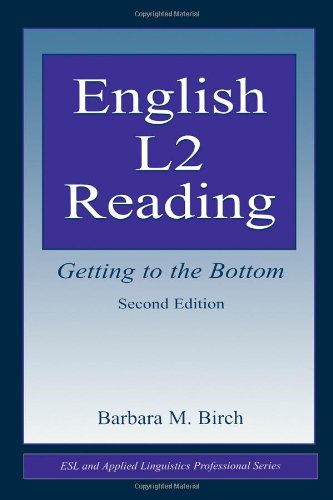Product desciption
English L2 Reading Getting To The Bottom 2nd Edition Barbara M Birch by Barbara M. Birch 9780805859294, 9781410614933, 0805859292, 141061493X instant download after payment.
English L2 Reading: Getting to the Bottom, Second Edition remains a comprehensive, myth-debunking examination of how L1 features (orthographic system, phonology, morphology) can influence English L2 reading at the “bottom” of the reading process. It provides a thorough but very accessible linguistic/psycholinguistic examination of the lowest levels of the reading process. It is both theoretical and practical. The goal is to balance or supplement (not replace) top-down approaches and methodologies with effective low-level options for teaching English reading. Core linguistic and psycholinguistic concepts are presented within the context of their application to teaching. The text clearly explains the strategies that readers of other languages develop in response to their own writing systems (Chinese, Japanese, Arabic, Hebrew, other alphabets, or transparent Roman alphabetic systems), contrasted with an explanation of the strategies that English readers develop in response to the opaque orthography of English, and explicates how other low-level processing strategies for L1 morphology and word formation may aid or hinder processing in English L2 reading acquisition. A complete, balanced reading ideology should be big enough to embrace all reading theories and practices. In particular, it should be able to accommodate those researchers and teachers who find that attention to the details of language can also help students learn to read better. Many ESL/EFL teachers are interested in supplementing their successful whole-language methods with bottom-up reading strategies, but aren’t sure how to do it. This book fills that gap. Changes in the Second Edition:*updated content in each chapter and clearer organization for the student to make the text more reader friendly;*expansion in Chapter 2 on alphabets, writing systems, and a brief history of written English and spelling;*extended discussion in Chapter 3 of the cognition of written language and reading transfer;*addition of phonemic, vocal, subvocal, and articulatory development and L2 reading processing in Chapter 4, as well as instructional activities and strategies for teaching these skills to L2 readers;*elaboration of graphs and graphemes in Chapter 5, including discussion of developing graphemic knowledge, processing strategies, and their instructional application, and new sections on reading speed, pattern recognition, and word recognition;*development of the probabilistic section in Chapter 6, particularly the probabilities in context of L2 reading;*updated information on the topic of brain activation studies; and*new treatment of the topic of reading fluency, added in responses to requests from many readers of the first edition. Intended for ESL/EFL reading researchers, teacher trainers and teachers, and as a text for MATESOL students, most chapters contain practical suggestions that teachers can incorporate into whole language methods to teach beginning or intermediate ESL/EFL reading (letters, pronunciation, “smart” phonics, morphemes, and vocabulary acquisition) in a more balanced way. Pre-reading discussion and study questions are provided to stimulate interest and enhance comprehension. End-of-chapter exercises help readers apply the concepts.


